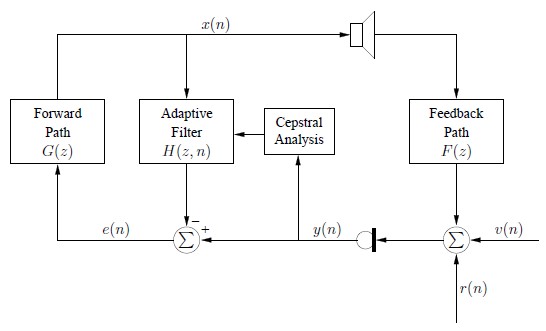
The present invention discloses a new approach to increase the maximum stable gain of a sound reinforcement system - the maximum gain value that does not cause the undesirable howling (feedback) effect. It extracts well-defined information from the cepstra of the acoustic system signals and uses this information to update the adaptive filter, responsible for controlling the acoustic feedback. This approach is based on a new theoretical analysis of the feedback cancellation problem that does not insert any other processing block and thus does not alter the fidelity of the whole reinforcement system. Results show that, using speech signals as source, the proposed Cepstrum-based method is able to present an improvement in the estimation of the impulse response of the feedback path when compared to other known methods.
In a public address system, the speaker’s speech signal, after being captured by the microphone, amplified and reproduced by the loudspeakers, may return to the microphone. This may cause a howling at a specific frequency, a phenomenon known as Larsen effect. In order to eliminate or, at least, to control the Larsen effect, several solutions have been developed over the years. However, the methods based on Phase-Modulation or Notch Filter achieve a small increase in the maximum stable gain of reinforcement systems. On the other hand, adaptive feedback cancelation methods based on the gradient or least-squares present a bias in the estimate of the feedback path due to the correlation between the microphone and loudspeaker signals, still resulting in a small increase in the maximum stable gain. Many solutions to overcome that bias propose the use of processing blocks to perform the decorrelation, but this may cause a signal distortion, negatively affecting the sound quality.
The utility of this invention is to better cancel the acoustic feedback and thus increase the maximum stable gain of reinforcement systems. In result, the sound reinforcement systems may produce a louder output without causing the undesirable howling (feedback) effect. Besides the adaptive filter, this approach does not additionally insert any other processing block, preserving the maximum fidelity of the system.
The results of tests in simulated environment in a computer showed that, using speech signals as source, the proposed Cepstrum-based method is able to present an improvement in the estimation of the impulse response of the feedback path when compared to the state-of-art PEM-AFROW method and, consequently, to increase much more the maximum stable gain. In addition, differently from the PEM-AFROW and other solutions, this invention is suitable for more general types of source signal as exemplified with white noise and speech signal.
The present invention may be incorporated in digital sound processors. It can also be embedded in sound reinforcement and amplification devices or in speech related audio equipment. The proposed method has also application in other technologies that use acoustic feedback cancellation solutions, namely in the hearing aids industry and in teleconference equipment.
A proteção dos direitos de propriedade industrial é cofinanciada por:






